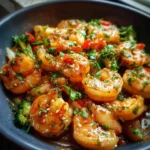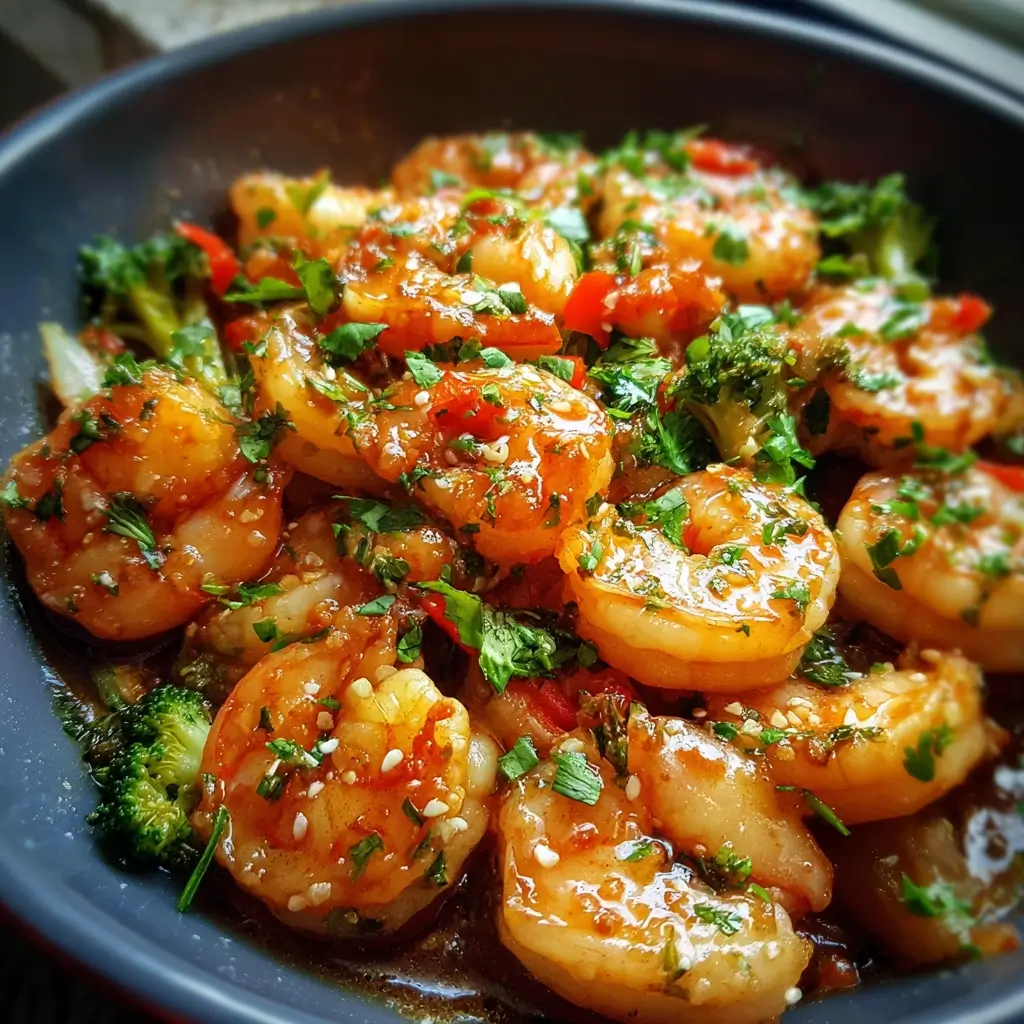There are certain weeknight dinners that become legends in a family, the ones that get requested time and time again. For us, this Sweet Chili Shrimp Stir-Fry is that meal. I remember the first time I made it, I was in a rush, staring at a bag of shrimp and a crisper drawer full of colorful vegetables, wondering how I could turn it into something exciting in under 30 minutes. The magic happened when I whisked together the glossy, vibrant sweet chili sauce. The moment it hit the hot pan, the entire kitchen filled with an irresistible aroma—a tantalizing blend of sweet, savory, and spicy. My husband, drawn in by the scent, peeked over my shoulder as I tossed the plump, pink shrimp and crisp-tender vegetables in the glistening sauce. The kids, who can sometimes be picky about vegetables, were completely mesmerized by the bright red bell peppers and vivid green broccoli. When we finally sat down to eat, there was a moment of silence, followed by a chorus of “Wow, this is amazing!” It was a total victory. The shrimp were perfectly cooked, the vegetables had a satisfying crunch, and the sauce coated every single bite with a flavor that was simply addictive. Now, it’s our go-to recipe for a delicious, healthy, and incredibly fast meal that feels like a restaurant-quality treat right at home. It’s more than just a recipe; it’s our solution to the “what’s for dinner?” dilemma, and it never fails to bring smiles to the table.
Ingredients
This recipe relies on a harmony of fresh components and a simple yet powerful sauce. Each ingredient is chosen for its specific contribution to the final flavor and texture, creating a perfectly balanced dish.
- For the Stir-Fry:
- 1.5 lbs Large Shrimp: Peeled and deveined. Using large shrimp (21-25 count per pound) ensures they remain juicy and plump after cooking.
- 1 tbsp Avocado Oil (or other high-smoke-point oil): Essential for stir-frying at high temperatures without burning. Canola or peanut oil are also great options.
- 1 Large Head of Broccoli: Cut into small, bite-sized florets. This provides a wonderful, earthy crunch and soaks up the sauce beautifully.
- 1 Red Bell Pepper: Cored, seeded, and thinly sliced. It adds a lovely sweetness and a vibrant splash of color.
- 1 Yellow or Orange Bell Pepper: Cored, seeded, and thinly sliced. This complements the red pepper in flavor and creates a visually stunning dish.
- 1 cup Snow Peas: Trimmed. These add a delicate sweetness and a signature crisp snap that is quintessential to a great stir-fry.
- 4 Cloves Garlic: Minced. A foundational aromatic that provides a pungent, savory depth.
- 1 tbsp Fresh Ginger: Grated or minced. It brings a warm, zesty spice that cuts through the sweetness of the sauce.
- For the Sweet Chili Sauce:
- ⅔ cup Sweet Chili Sauce: This is the star of the show. Choose a good quality store-bought sauce for convenience, or make your own for full control over the sweetness and spice level.
- ¼ cup Low-Sodium Soy Sauce (or Tamari): Provides the salty, umami backbone of the sauce. Use tamari for a gluten-free option.
- 2 tbsp Rice Vinegar: Adds a bright, acidic tang that balances the sweetness and saltiness.
- 1 tbsp Sesame Oil: A finishing oil with a distinct nutty, toasty flavor. It’s added for aroma and taste, not for cooking.
- 1 tbsp Cornstarch: Mixed with 2 tablespoons of water to create a slurry. This is the secret to a thick, glossy sauce that clings perfectly to every ingredient.
- For Garnish (Optional):
- Toasted Sesame Seeds: For a nutty crunch and visual appeal.
- Sliced Green Onions: Adds a mild, fresh oniony bite.
- Chopped Fresh Cilantro: Brings a bright, herbaceous note that freshens up the entire dish.
Instructions
The key to a successful stir-fry is preparation and speed. Have all your ingredients chopped, measured, and ready to go before you even turn on the stove. This process, known as mise en place, is non-negotiable for achieving that perfect crisp-tender texture. The cooking happens very quickly!
- Prepare the Sauce: In a small bowl, whisk together the sweet chili sauce, low-sodium soy sauce (or tamari), and rice vinegar. In a separate, very small bowl, mix the cornstarch with 2 tablespoons of cold water until it’s completely smooth and no lumps remain. This is your cornstarch slurry. Set both the sauce mixture and the slurry aside.
- Pat the Shrimp Dry: Use paper towels to pat the peeled and deveined shrimp completely dry. This is a crucial step to ensure the shrimp sear rather than steam in the pan, giving them a much better texture and flavor. Season them lightly with a pinch of salt and black pepper.
- Heat the Pan: Place a large skillet or a wok over medium-high heat. Add the avocado oil and let it get hot. You’ll know it’s ready when the oil shimmers slightly. A hot pan is essential for getting a good, quick sear on the ingredients.
- Cook the Shrimp: Carefully add the shrimp to the hot pan in a single layer. Be careful not to overcrowd the pan; cook in two batches if necessary. Cook for 1-2 minutes per side, just until they turn pink and opaque and curl into a “C” shape. An overcooked shrimp is tough and rubbery, so watch them closely. Once cooked, immediately remove the shrimp from the pan and set them aside on a clean plate.
- Sauté the Aromatics: Add the minced garlic and grated ginger to the same skillet. Stir constantly for about 30 seconds until they are fragrant. Be very careful not to let them burn, as burnt garlic will make the entire dish bitter.
- Cook the Vegetables: Add the broccoli florets and sliced bell peppers to the skillet. Stir-fry for 3-4 minutes. You want them to become vibrant in color and slightly tender but still have a distinct crunch. The high heat will char them slightly in spots, which adds a wonderful smoky flavor.
- Add the Snow Peas: Toss the snow peas into the skillet and cook for another 1-2 minutes. Snow peas cook very quickly, and you want to preserve their signature snap.
- Combine and Sauce: Return the cooked shrimp to the skillet with the vegetables. Give the sauce mixture a quick re-whisk and pour it over everything. Stir to coat all the ingredients evenly.
- Thicken the Sauce: As the sauce begins to bubble, give your cornstarch slurry another quick stir (it can settle) and pour it into the pan. Continue to stir constantly. The sauce will thicken up into a beautiful, glossy glaze in about 1-2 minutes.
- Final Touches: Remove the skillet from the heat. Stir in the toasted sesame oil. This is added off the heat to preserve its delicate, nutty flavor.
- Serve Immediately: Garnish your Sweet Chili Shrimp Stir-Fry with toasted sesame seeds, sliced green onions, and fresh cilantro, if desired. Serve hot and enjoy the incredible flavors.
Nutrition Facts
This recipe is designed to be a balanced and satisfying meal. The nutritional information is an estimate and can vary based on specific ingredients used.
- Servings: 4-6
- Calories Per Serving: Approximately 420-480 kcal (based on 4 servings, excluding rice or noodles)
- Protein (Approx. 30g): The shrimp provides a significant amount of high-quality, lean protein, which is essential for muscle repair, immune function, and keeping you feeling full and satisfied.
- Fiber (Approx. 6g): Loaded with vegetables like broccoli, bell peppers, and snow peas, this dish is a good source of dietary fiber. Fiber is crucial for digestive health, regulating blood sugar levels, and maintaining a healthy weight.
- Vitamin C (Over 100% of RDI): Bell peppers and broccoli are powerhouses of Vitamin C, a vital antioxidant that supports the immune system, promotes healthy skin, and helps the body absorb iron.
- Sodium (Approx. 700mg): While delicious, the sauce contributes most of the sodium. Using low-sodium soy sauce helps manage this. For an even lower-sodium version, you can reduce the amount of soy sauce or use coconut aminos as an alternative.
- Healthy Fats (Approx. 15g): The use of avocado oil and sesame oil contributes heart-healthy monounsaturated and polyunsaturated fats, which are beneficial for overall cardiovascular health.
Preparation Time
This meal is a champion of speed, making it perfect for busy weeknights. The majority of the time is spent on prep, while the actual cooking is a flash in the pan.
- Prep Time (15-20 minutes): This includes washing and chopping the vegetables, peeling and deveining the shrimp (if not already done), mincing the garlic and ginger, and measuring out the sauce ingredients. Investing this time upfront makes the cooking process smooth and stress-free.
- Cook Time (10-12 minutes): Stir-frying is a high-heat, high-speed cooking method. From the moment the shrimp hit the pan to the final stir of the sauce, the entire cooking process is incredibly fast.
- Total Time: Approximately 25-30 minutes from start to finish.
How to Serve
The versatility of this stir-fry allows for numerous serving options, catering to different dietary preferences and occasions. Presentation can elevate this simple dish into something truly special.
- Classic Grain Pairings:
- Jasmine Rice: The fragrant, slightly sticky texture of jasmine rice is the perfect vessel for soaking up every last drop of the delicious sweet chili sauce.
- Brown Rice: For a healthier, whole-grain option, serve with nutty-tasting brown rice. It adds extra fiber and nutrients.
- Quinoa: A protein-packed, gluten-free option that provides a fluffy texture and a slightly earthy flavor that complements the stir-fry well.
- Noodle and Low-Carb Options:
- Rice Noodles: Toss the stir-fry with cooked rice noodles for a dish reminiscent of Pad Thai.
- Cauliflower Rice: A fantastic low-carb, grain-free alternative. Its neutral flavor allows the sweet chili shrimp to be the star.
- Zucchini Noodles (“Zoodles”): For a fresh, light, and keto-friendly meal, serve the stir-fry over a bed of raw or lightly sautéed zucchini noodles.
- Garnishes for a Finishing Touch:
- Crunch: Toasted sesame seeds or chopped peanuts add a wonderful textural contrast.
- Freshness: A generous sprinkle of fresh cilantro or sliced green onions brightens up the flavors.
- Acidity: A wedge of lime on the side allows each person to add a fresh squeeze of citrus, cutting through the richness and enhancing the shrimp’s flavor.
- Heat: For those who love extra spice, a drizzle of sriracha or a few red pepper flakes on top works beautifully.
- Family-Style Serving:
- Serve the stir-fry in a large platter or bowl in the center of the table, with bowls of rice and various garnishes on the side. This creates an engaging, communal dining experience where everyone can build their own perfect bowl.
Additional Tips
Mastering a stir-fry is all about technique. These eight tips will help you move from a good stir-fry to a great one, ensuring perfect results every single time.
- Don’t Overcook the Shrimp: This is the most common mistake. Shrimp cook in a matter of minutes. The best indicator of doneness is their shape. They start straight, then curl into a “C” shape when they are perfectly cooked. If they curl into a tight “O,” they are overcooked and will be tough. Cook them first, remove them from the pan, and add them back at the very end.
- The Secret to Crisp-Tender Veggies: The goal is vegetables that are cooked through but still have a bite. The secret is high heat and constant motion. Don’t cover the pan, as this will trap steam and make the vegetables soft and soggy. Keep them moving in the hot pan to ensure they cook evenly and quickly.
- Get Your Pan Screaming Hot: Before you add any food, your wok or skillet should be very hot. This allows the ingredients to sear instantly when they make contact, creating flavor (through the Maillard reaction) and preventing them from releasing too much water. A few drops of water should sizzle and evaporate instantly when flicked into the pan.
- Don’t Crowd the Pan: This is just as important as high heat. If you put too much food in the pan at once, the pan’s temperature will drop dramatically. Instead of stir-frying, your ingredients will steam in their own juices, resulting in a watery, grey-looking dish. If your skillet isn’t large enough, cook the shrimp and vegetables in batches.
- Mise en Place is Non-Negotiable: As mentioned in the instructions, this French term for “everything in its place” is the golden rule of stir-frying. The cooking process is too fast to stop and chop a bell pepper or measure out soy sauce. Have every single ingredient prepped and within arm’s reach before you turn on the heat.
- Customize Your Vegetables: This recipe is a fantastic template. Feel free to swap in your favorite vegetables or use whatever you have in your fridge. Great additions or substitutions include:
- Bok Choy (add stems first, leaves at the end)
- Mushrooms (cremini or shiitake)
- Carrot ribbons (use a vegetable peeler)
- Snap Peas
- Water Chestnuts (for crunch)
- Baby Corn
- Making it Spicier (or Milder): The level of heat is easily adjustable. For more spice, add a teaspoon of sriracha or a pinch of red pepper flakes to the sauce. You could also add a fresh, thinly sliced chili pepper with the garlic and ginger. To make it milder for kids or sensitive palates, ensure you’re using a mild brand of sweet chili sauce.
- Batch Cooking and Meal Prep: You can make your life even easier by prepping the components ahead of time. Chop all the vegetables, mince the garlic and ginger, and store them in an airtight container in the fridge. You can also whisk the sauce together and store it separately. When you’re ready to eat, the cooking process will take less than 15 minutes.
Frequently Asked Questions (FAQ)
Here are answers to some of the most common questions about making this Sweet Chili Shrimp Stir-Fry.
1. Can I use frozen shrimp for this recipe?
Absolutely! Frozen shrimp is often more convenient and can be of excellent quality. The key is to thaw it properly. The best method is to place the frozen shrimp in a colander in the sink and run cold water over them for 5-10 minutes, tossing them occasionally until thawed. Alternatively, you can thaw them overnight in the refrigerator. Most importantly, after thawing, you must pat them completely dry with paper towels to ensure they sear properly.
2. How do I make this recipe gluten-free?
Making this stir-fry gluten-free is very simple. The primary source of gluten is the soy sauce. Simply substitute the low-sodium soy sauce with an equal amount of Tamari, which is a Japanese soy sauce brewed without wheat, or use coconut aminos, which is a slightly sweeter, soy-free alternative. You should also double-check the label on your sweet chili sauce, as some brands may contain gluten-based thickeners, though most are naturally gluten-free.
3. What is the best pan to use for stir-frying if I don’t have a wok?
While a carbon steel wok is the traditional and ideal choice because its shape provides varied heat zones, you can absolutely make a fantastic stir-fry without one. The best alternative is a large, wide skillet with sloped sides, preferably made of cast iron or stainless steel. The key is size—you need enough surface area to cook the ingredients in a single layer without overcrowding them. Avoid non-stick pans if possible, as they generally cannot be heated to the high temperatures required for a proper sear.
4. How do I store and reheat leftovers?
Store any leftovers in an airtight container in the refrigerator for up to 2-3 days. To reheat, it’s best to do so gently to avoid overcooking the shrimp and making the vegetables mushy. The best method is to reheat in a skillet over medium-low heat with a splash of water or broth to create steam and prevent it from drying out. You can also microwave it in short 30-second bursts, stirring in between, until just warmed through.
5. Can I make my own sweet chili sauce from scratch?
Yes, and it’s surprisingly easy! For a simple homemade version, combine ½ cup of water, ¼ cup of rice vinegar, ¼ cup of sugar (or honey), 1-2 tablespoons of chili garlic sauce (like sambal oelek), and 1 tablespoon of soy sauce in a small saucepan. Bring to a simmer and then add a cornstarch slurry (1 tbsp cornstarch + 2 tbsp water) to thicken it to your desired consistency. This allows you to control the sweetness, spiciness, and sodium content completely.
6. My stir-fry sauce came out watery. What did I do wrong?
A watery stir-fry is usually caused by one of three things:
- Low Heat: The pan wasn’t hot enough, causing the vegetables to release water and steam instead of searing.
- Crowding the Pan: Too many ingredients at once lowered the pan’s temperature, leading to the same steaming effect.
- Not Activating the Cornstarch: The sauce needs to come to a full simmer or bubble for the cornstarch slurry to activate and work its thickening magic. Ensure you stir it constantly as it heats up.
7. Can I use a different protein like chicken, beef, or tofu?
Yes, this recipe is incredibly versatile.
- For Chicken: Use 1.5 lbs of boneless, skinless chicken breast or thighs, cut into thin, bite-sized pieces. Sauté the chicken until it’s cooked through and golden brown, then remove it from the pan and proceed with the recipe as written, adding it back in at the end.
- For Beef: Use flank steak or sirloin, thinly sliced against the grain. Sear it quickly over very high heat for 1-2 minutes until browned but still pink inside, then remove and add it back at the very end.
- For Tofu: Use a block of extra-firm tofu. Press it for at least 30 minutes to remove excess water, then cube it. Pan-fry the cubes until golden and crispy on all sides before starting the vegetables, then set aside and add them back in with the sauce.
8. Is this recipe considered healthy?
Yes, it’s a very well-balanced and healthy meal. It is packed with lean protein from the shrimp and loaded with nutrient-dense, high-fiber vegetables. By controlling the ingredients, you can make it even healthier. Use low-sodium soy sauce, choose a sweet chili sauce with less sugar, load up on even more vegetables, and serve it over a whole grain like brown rice or quinoa to create a powerhouse of nutrition that doesn’t sacrifice any flavor.

Sweet Chili Shrimp Stir-Fry Recipe
Ingredients
This recipe relies on a harmony of fresh components and a simple yet powerful sauce. Each ingredient is chosen for its specific contribution to the final flavor and texture, creating a perfectly balanced dish.
- For the Stir-Fry:
- 1.5 lbs Large Shrimp: Peeled and deveined. Using large shrimp (21–25 count per pound) ensures they remain juicy and plump after cooking.
- 1 tbsp Avocado Oil (or other high-smoke-point oil): Essential for stir-frying at high temperatures without burning. Canola or peanut oil are also great options.
- 1 Large Head of Broccoli: Cut into small, bite-sized florets. This provides a wonderful, earthy crunch and soaks up the sauce beautifully.
- 1 Red Bell Pepper: Cored, seeded, and thinly sliced. It adds a lovely sweetness and a vibrant splash of color.
- 1 Yellow or Orange Bell Pepper: Cored, seeded, and thinly sliced. This complements the red pepper in flavor and creates a visually stunning dish.
- 1 cup Snow Peas: Trimmed. These add a delicate sweetness and a signature crisp snap that is quintessential to a great stir-fry.
- 4 Cloves Garlic: Minced. A foundational aromatic that provides a pungent, savory depth.
- 1 tbsp Fresh Ginger: Grated or minced. It brings a warm, zesty spice that cuts through the sweetness of the sauce.
- For the Sweet Chili Sauce:
- ⅔ cup Sweet Chili Sauce: This is the star of the show. Choose a good quality store-bought sauce for convenience, or make your own for full control over the sweetness and spice level.
- ¼ cup Low-Sodium Soy Sauce (or Tamari): Provides the salty, umami backbone of the sauce. Use tamari for a gluten-free option.
- 2 tbsp Rice Vinegar: Adds a bright, acidic tang that balances the sweetness and saltiness.
- 1 tbsp Sesame Oil: A finishing oil with a distinct nutty, toasty flavor. It’s added for aroma and taste, not for cooking.
- 1 tbsp Cornstarch: Mixed with 2 tablespoons of water to create a slurry. This is the secret to a thick, glossy sauce that clings perfectly to every ingredient.
- For Garnish (Optional):
- Toasted Sesame Seeds: For a nutty crunch and visual appeal.
- Sliced Green Onions: Adds a mild, fresh oniony bite.
- Chopped Fresh Cilantro: Brings a bright, herbaceous note that freshens up the entire dish.
Instructions
The key to a successful stir-fry is preparation and speed. Have all your ingredients chopped, measured, and ready to go before you even turn on the stove. This process, known as mise en place, is non-negotiable for achieving that perfect crisp-tender texture. The cooking happens very quickly!
- Prepare the Sauce: In a small bowl, whisk together the sweet chili sauce, low-sodium soy sauce (or tamari), and rice vinegar. In a separate, very small bowl, mix the cornstarch with 2 tablespoons of cold water until it’s completely smooth and no lumps remain. This is your cornstarch slurry. Set both the sauce mixture and the slurry aside.
- Pat the Shrimp Dry: Use paper towels to pat the peeled and deveined shrimp completely dry. This is a crucial step to ensure the shrimp sear rather than steam in the pan, giving them a much better texture and flavor. Season them lightly with a pinch of salt and black pepper.
- Heat the Pan: Place a large skillet or a wok over medium-high heat. Add the avocado oil and let it get hot. You’ll know it’s ready when the oil shimmers slightly. A hot pan is essential for getting a good, quick sear on the ingredients.
- Cook the Shrimp: Carefully add the shrimp to the hot pan in a single layer. Be careful not to overcrowd the pan; cook in two batches if necessary. Cook for 1-2 minutes per side, just until they turn pink and opaque and curl into a “C” shape. An overcooked shrimp is tough and rubbery, so watch them closely. Once cooked, immediately remove the shrimp from the pan and set them aside on a clean plate.
- Sauté the Aromatics: Add the minced garlic and grated ginger to the same skillet. Stir constantly for about 30 seconds until they are fragrant. Be very careful not to let them burn, as burnt garlic will make the entire dish bitter.
- Cook the Vegetables: Add the broccoli florets and sliced bell peppers to the skillet. Stir-fry for 3-4 minutes. You want them to become vibrant in color and slightly tender but still have a distinct crunch. The high heat will char them slightly in spots, which adds a wonderful smoky flavor.
- Add the Snow Peas: Toss the snow peas into the skillet and cook for another 1-2 minutes. Snow peas cook very quickly, and you want to preserve their signature snap.
- Combine and Sauce: Return the cooked shrimp to the skillet with the vegetables. Give the sauce mixture a quick re-whisk and pour it over everything. Stir to coat all the ingredients evenly.
- Thicken the Sauce: As the sauce begins to bubble, give your cornstarch slurry another quick stir (it can settle) and pour it into the pan. Continue to stir constantly. The sauce will thicken up into a beautiful, glossy glaze in about 1-2 minutes.
- Final Touches: Remove the skillet from the heat. Stir in the toasted sesame oil. This is added off the heat to preserve its delicate, nutty flavor.
- Serve Immediately: Garnish your Sweet Chili Shrimp Stir-Fry with toasted sesame seeds, sliced green onions, and fresh cilantro, if desired. Serve hot and enjoy the incredible flavors.
Nutrition
- Serving Size: one normal portion
- Calories: 480
- Sodium: 700mg
- Fat: 15g
- Fiber: 6g
- Protein: 30g






